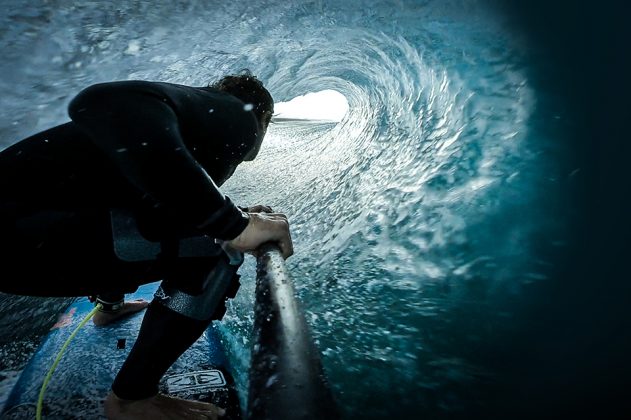A BIT ABOUT WATER
With – Dom Moore
You won’t get very far on your sup without it. But what is it about this special substance that makes it the right consistency for us to float on? How come we don’t dig holes in it when we paddle? Why are rain drops round? Why is there surface tension? Why does it paradoxically freeze from the top down? And are cold water wipeouts really more brutal?
First, let’s remind ourselves what water is made up of: one oxygen atom and two hydrogen atoms, giving us the chemical symbol H2O. Two common elements throughout our bodies, planet and universe, but what makes them join together in such a uniform molecule? Well, zooming in a little bit closer on our oxygen and hydrogen atoms, we can see that they have electrons which possess a negative charge, buzzing around the nucleus which carries a positive charge, in orbital shells. For mental modelling purposes we can think of them as moons circling a large planet though there’s a bit more to it than that. Electrons aren’t arranged around the nucleus haphazardly for atoms, like everything in nature which they make up, are constantly trying to reduce down to the lowest possible stable energy level, which happens to be an eight electrons in their outer orbital shell. Like this, an atom wants for nothing, it can bimble about all content with its eight electron outer shell. The thing is, tiny little hydrogen being the smallest of all atoms only has one electron, whilst greedy oxygen has six – two short of an eight pack. So what happens? You guessed it, two hydrogen and one oxygen join forces to create a new molecule with eight electrons in the outer shell. We call this a covalent bond; the atoms are being good to each other.
107.5 DEGREES
In case you weren’t already gripping the edge of your seat, this where the fun starts. Oxygen forms a single bond with each hydrogen, meaning they share one electron each. This leaves four of oxygen’s electrons hanging around like surplus teenage males in a nightclub, and like that they end up repelling the two hydrogen somewhat, creating a bent molecule with two hydrogens with an angle between them of 107.5 degrees on one side and one oxygen with four electrons on the other side. This creates a polarity – just like a battery or a magnet – in the H2O molecule where the oxygen side has a little bit of a negative charge and the hydrogen side has a little bit of a positive charge. So yes, mind blown, water is electric!
“Surface tension is wonderful phenomenon that cleans up windy surf when a set rolls through, or gives you the extra slap when the lip pitches you into the flats”
COME TOGETHER
Now we can see why water molecules are keen to join together: the intramolecular polarity creates an attractive force and that is why water flows back together and you can’t punch holes in it. It’s why raindrops are spherical – all the molecules are pulling each other with equal force so it’s the most efficient shape. When water is in its liquid phase, the H2O molecules are free to rotate around to form and break bonds with neighbouring molecules. It’s a bit like a crowd of people milling around and shaking hands with one another, each handshake is a hydrogen bond and sooner or later the crowd will gather in the middle of a room. Now this leads on to why we have surface tension, that wonderful phenomenon that cleans up windy surf when a set rolls through, or gives you the extra slap when the lip pitches you into the flats. As we all know, the surface of water has a skin on it. Water molecules can be either under water pulling at each other in all directions, or on the surface pulling only downwards and side to side. This sideways and downwards pulling creates a bunching effect, giving us surface tension.
DENSITY
First up, let’s get the figures out there: sea water has a density of 1030 kg per m3. Fresh water is 1000 kg per m3, and ice 917 kg per m3.
Sea water has more density than fresh water because of the extra elements added to it, sodium and chlorine, which combine together to form sodium chloride, a.k.a. salt. The bonding process is not really relevant to go into, but it’s again thanks to the polar property of water that salt dissolves in water and disperses throughout it, rather than just sinking, that sea water is more dense than fresh water on, average by about 3% across the oceans. So this means that if you want the equivalent buoyancy on fresh water for your race board, you’re going to have to add some volume. The precise amount would depend on the density of your board (you can calculate this by dividing its weight by volume) and other maths which I’m too jet lagged to work out but roughly adding 5% would be a good place to start. Please do send in workings if you have them.
We know that water becomes denser as it cools (which is why it’s colder when you swim down), but does this mean that wipeouts in the tropics are less brutal than in cold water in similar surf? Well, seawater density increases by less than 3 kg per ton from 20°C to 0°C at a constant salinity, that’s 0.3%, so unless you are hypersensitive that beat down at Peahi is going to be every bit as devastating as it is at Mavericks.
What is relevant to us though is that water as in fact at its most dense at 4°C. Again the difference is so tiny we wouldn’t notice, but as anyone who’s neglected to put antifreeze in an engine or left the beers in the freezer will tell you, it matters. Back to those hydrogen bonds between water molecules, as water cools, the molecules slow down and stop rotating until they freeze. Instead of making and breaking bonds, they lock onto each other on all six sides (imagine a cube) and form a solid lattice, ice. Because the molecules are no longer rotating and sliding around each other they bristle out, taking up more space, with less mass for the same volume, like a crowd of people holding each other at arm’s length. And this effect occurs at temperatures below 4°C. And that is why lakes, rivers and the sea don’t freeze from the bottom up which would have killed everything in them some time ago, presumably precluding our existence today… SUP


